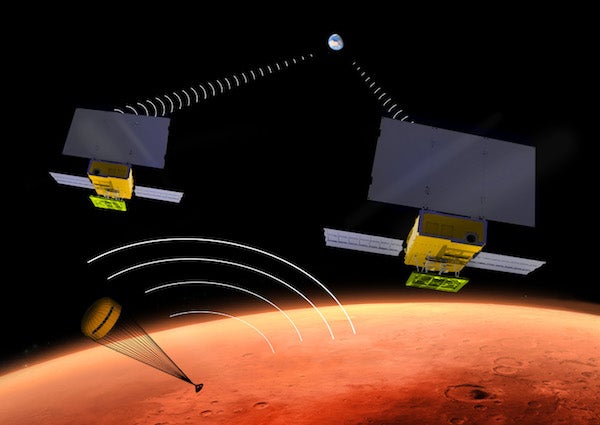This article was published in Scientific American’s former blog network and reflects the views of the author, not necessarily those of Scientific American
With a launch window opening in May 2018 the robotic InSight probe is nearly on its way to Mars. If all goes well, in late November 2018 the lander will touchdown on the western side of Elysium Planitia, a broad plane sitting across the martian equator. This spot is about 600 kilometers north of where the Curiosity rover is roaming, and almost due south of the much more northerly location of the 42-year-old Viking 2 lander.
Insight’s primary scientific focus is on the interior of Mars. It’s sensitive seismometer is supported by a host of other instruments, including a thermal probe that should burrow up to 5 meters into the regolith, and an X-band transmitter to enable to precise tracking of the planet’s variations in spin and orientation.
It’s a very nice scientific mission, but it’s also a very cool testbed for something that’s received a little less attention. When InSight launches, its Atlas-V upper stage will be carrying hitchhikers - in the form of a pair of briefcase-sized cubesats.
On supporting science journalism
If you're enjoying this article, consider supporting our award-winning journalism by subscribing. By purchasing a subscription you are helping to ensure the future of impactful stories about the discoveries and ideas shaping our world today.
Like InSight, these two small spacecraft, together called Mars Cube One (or MarCO), will be boosted to a Mars-bound interplanetary trajectory. After trailing InSight on its way through the solar system, the solar-powered cubesats will serve as critical data relays while InSight plunges into the Martian atmosphere – where it will deploy a parachute at high speeds to slow down and finally use 12 small descent engines to lower itself to the surface.
Without these twin cubesats, data from the InSight probe that is relayed via the Mars Reconnaissance Orbiter can be delayed by as much as an hour because the Reconnaissance Orbiter has limitations on its ability to both receive and transmit simultaneously. MarCO will act like a ‘bring your own’ data relay, giving NASA prompt information about InSight’s landing (after the signals have traversed the distance from Mars to Earth of course).
The compact size of the MarCO twins also means that their radio dishes have to be a little different. Both use a so-called ‘reflectarray’ – a flat antennae that is patterned to mimic a parabolic dish, in order to help focus transmissions towards Earth.

Credit: NASA and JPL-Caltech
While MarCO is not essential to the success of InSight, it is a key demonstration of a new kind of planetary, and interplanetary support system. In the future these diminutive craft could help human exploration too.
This test has plenty of risk though. The two devices have to pass by Mars at the right moment – shooting past at about 3,500 kilometers distance - while InSight is plunging to the surface, and they have to orientate themselves in order to relay data back to the Deep Space Network on Earth.
It’s going to be an interest ballet taking place high above Mars this coming November.